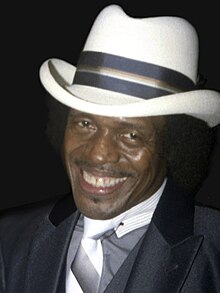Portal:Blues
The Blues Portal

Blues is a music genre and musical form that originated amongst African-Americans in the Deep South of the United States around the 1860s. Blues has incorporated spirituals, work songs, field hollers, shouts, chants, and rhymed simple narrative ballads from the African-American culture. The blues form is ubiquitous in jazz, rhythm and blues, and rock and roll, and is characterized by the call-and-response pattern, the blues scale, and specific chord progressions, of which the twelve-bar blues is the most common. Blue notes (or "worried notes"), usually thirds, fifths or sevenths flattened in pitch, are also an essential part of the sound. Blues shuffles or walking bass reinforce the trance-like rhythm and form a repetitive effect known as the groove.
Blues music is characterized by its lyrics, bass lines, and instrumentation. Early traditional blues verses consisted of a single line repeated four times. It was only in the first decades of the 20th century that the most common current structure became standard: the AAB pattern, consisting of a line sung over the four first bars, its repetition over the next four, and then a longer concluding line over the last bars. Early blues frequently took the form of a loose narrative, often relating the racial discrimination and other challenges experienced by African-Americans.
Many elements, such as the call-and-response format and the use of blue notes, can be traced back to the music of Africa. The origins of the blues are also closely related to the religious music of the African-American community, the spirituals. The first appearance of the blues is often dated to after the ending of slavery, with the development of juke joints occurring later. It is associated with the newly acquired freedom of the former slaves. Chroniclers began to report about blues music at the dawn of the 20th century. The first publication of blues sheet music was in 1908. Blues has since evolved from unaccompanied vocal music and oral traditions of slaves into a wide variety of styles and subgenres. Blues subgenres include country blues, Delta blues and Piedmont blues, as well as urban blues styles such as Chicago blues and West Coast blues. World War II marked the transition from acoustic to electric blues and the progressive opening of blues music to a wider audience, especially white listeners. In the 1960s and 1970s, a hybrid form called blues rock developed, which blended blues styles with rock music. (Full article...)
Selected article -
Boogie-woogie is a genre of blues music that became popular during the late 1920s, developed in African-American communities since the 1870s. It was eventually extended from piano to piano duo and trio, guitar, big band, country and western music, and gospel. While standard blues traditionally expresses a variety of emotions, boogie-woogie is mainly dance music (although not usually played for the competitive dance known as boogie-woogie (dance), a term of convenience in that sport). The genre had a significant influence on rhythm and blues and rock and roll.
Boogie-woogie waned in popularity in the 1930s, but enjoyed a resurgence and its greatest acclaim in the 1940s, reaching audiences around the world. Among its most famous acts was the "Boogie Woogie Trio" of Pete Johnson, Albert Ammons, and Meade "Lux" Lewis. Other famous boogie woogie pianists of this peak era were Maurice Rocco and Freddie Slack. There were also many very notable women boogie woogie pianists during this time, including Hadda Brooks, Winifred Atwell, Martha Davis, and Hazel Scott, as well as in later years, such as Katie Webster. (Full article...)
Selected picture
Quotes
| “ | Blues is really America's finest art form and most dominant art form of the 20th century. | ” |
| — Georgie Fame | ||
| “ | Blues is a natural fact, something that a fellow lives. If you don't live it, you don't have it. | ” |
| — Big Bill Broonzy | ||
| “ | The blues is a low-down achin' heart disease Like consumption killing me by degrees. |
” |
| — Robert Johnson, "Preaching Blues (Up Jumped the Devil)" | ||
| “ | When you lay down at night, turning from one side of the bed to the other and can't sleep, what's the matter? Blues got you. | ” |
| — Lead Belly | ||
| “ | The blues had a baby and they named it rock and roll. | ” |
| — Muddy Waters | ||
Selected biography -
Junior Wells (born Amos Wells Blakemore Jr.; December 9, 1934 – January 15, 1998) was an American singer, harmonica player, and recording artist. He is best known for his signature song "Messin' with the Kid" and his 1965 album Hoodoo Man Blues, described by the critic Bill Dahl as "one of the truly classic blues albums of the 1960s". Wells himself categorized his music as rhythm and blues.
Wells performed and recorded with various notable blues musicians, including Muddy Waters, Earl Hooker, and Buddy Guy. He remained a fixture on the blues scene throughout his career and also crossed over to rock audiences while touring with the Rolling Stones. Not long before Wells died, the blues historian Gerard Herzhaft called him "one of the rare active survivors of the 'golden age of the blues'". (Full article...)
General images -
Things to do
Tasks template
 |
Here are some tasks awaiting attention:
|
- –When a task is completed, please remove it from the list.
WikiProjects
Categories
Related portals
Wikimedia
The following Wikimedia Foundation sister projects provide more on this subject:
-
Commons
Free media repository -
Wikibooks
Free textbooks and manuals -
Wikidata
Free knowledge base -
Wikinews
Free-content news -
Wikiquote
Collection of quotations -
Wikisource
Free-content library -
Wikispecies
Directory of species -
Wikiversity
Free learning tools -
Wikivoyage
Free travel guide -
Wiktionary
Dictionary and thesaurus






































































































